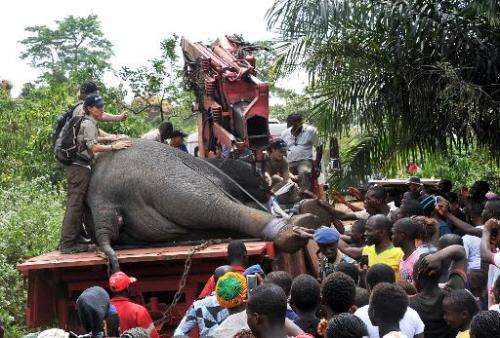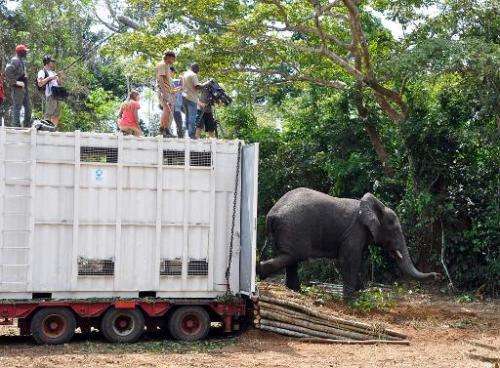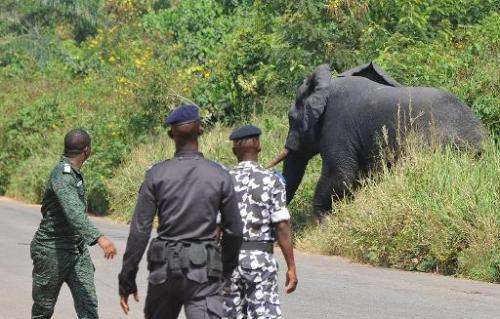Ivory Coast elephants get new home as habitat shrinks

As the spooked elephant starts to run, the vet pulls the trigger. Just a few minutes later the huge beast slumps to the floor unconscious, ready for Ivory Coast's first elephant relocation.
These hunters are not interested in the elephant's ivory. Instead, they want to protect people from the animal—and vice-versa—around Daloa, a town in the centre of the country where humans and elephants have recently come into conflict.
This is because the animals' local habitat, the Marahoue national park, has been eaten away bit by bit by agriculture.
"The forest was devastated and the animals fled the park," said Ibo Nahonain, head of Tapeguhe village just outside Daloa. "Gradually they came here."
Life with the five-tonne beasts has its upsides and downsides. "Sometimes they come within 100 metres of the village and everyone goes out to have a look at them," said Nahonain.
"But the women and children who have to go out to the fields go with fear in their hearts."
Three people have died, trampled by elephants, and others have been injured, while the animals also destroy the villagers' crops.
"They came three days in a row," said Aristide Sery Brito. "They spoiled my cocoa plants and my banana plants, and devastated some of my yams."
It became clear that one of the area's two groups of occupants would have to leave, and the government decided to resettle the animals in the Azagny national park, 20,000 hectares of virgin forest 400 kilometres (250 miles) to the south of Daloa.

"In moving this herd of elephants we are acting as conservationists. At the same time, we are ensuring the wellbeing and safety of the population," said Elvire-Joelle Mailly, director of wildlife at the ministry for forests and water.
Ivory Coast used to be home to thousands of elephants, but their numbers have dwindled to barely a few hundred, according to the government.
After months of preparation, the process of tracking down the animals in thick jungle began on January 19. Vets were then sent in, either on foot or by helicopter, to inject the tranquilliser.
"After that the hardest thing is to get them onto the truck," said Pete Morkel, a vet with International Fund for Animal Welfare (IFAW), which is helping to fund and carry out the relocation.
Despite the vets' precautions, two elephants have died in the process. One suffered a heart attack as a result of the tranquilliser, and one fell into a lake as the drug was taking effect and drowned.
"It's very sad. We were aware of the risk. It became reality," said Celine Sissler-Bienvenu, IFAW's director of France and French-speaking Africa.
"It affected us a lot. But it shows that relocation of elephants can only be a solution of last resort."
Footage of a successful capture shows a groggy elephant sitting back onto its hind legs before being pushed onto its side by vets, aided by villagers.

Then a crane is used to lift the elephant onto the platform of a truck, before being secured in a huge white metal cage where an antidote is administered.
The animal is then transferred to another cage, which is placed on a trailer designed to transport tanks and begins its journey across the country.
Hundreds of people gathered to watch the animal leave Daloa, and a cry went up as the truck began to move.
When it arrived at its destination 15 hours later, the cage was opened. A soft trumpeting sound emerged, followed by the animal, moving slowly and awkwardly, seemingly taking in its new surroundings.
"Censuses show that there are already elephants here. We have to hope they have had a good, long life in the park," said Sissler-Bienvenu. "If this can increase the birth rate, we will be happy."
Just one problem—the four animals that have so far been transported are all males.
© 2014 AFP



















